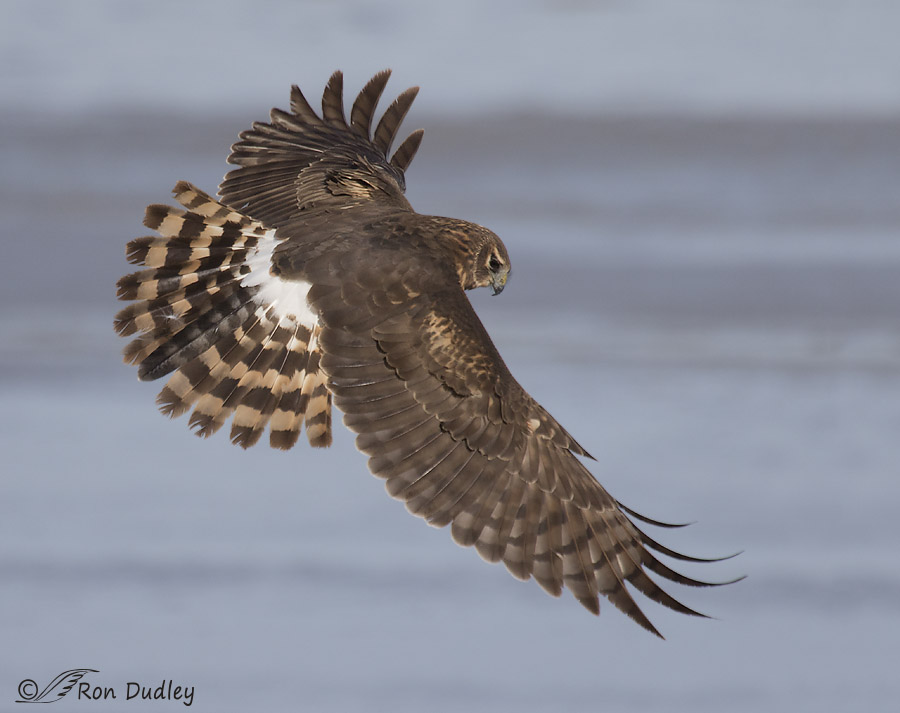I had some fun with a rather unique Northern Harrier yesterday morning.
 1/2000, f/8, ISO 500, Canon 7D Mark II, Canon 100-400 @ 400mm, 1.4 tc, canvas added for composition, not baited, set up or called in
1/2000, f/8, ISO 500, Canon 7D Mark II, Canon 100-400 @ 400mm, 1.4 tc, canvas added for composition, not baited, set up or called in
The bird was intent on its hunting and mostly ignored my pickup as it did so. I got a fair number of flight shots I like but it wasn’t easy because this was another instance of having to shoot out my window as I drove about 25 mph, steering with my knee and firing in short bursts. It’s times like this that I’m rewarded for shooting very early in the morning on deserted back roads or dirt tracks where I don’t have to worry about traffic. Once again I thought my old 100-400mm lens with attached teleconverter performed reasonably well. If I’d been using my 500mm the bird would have been crisper but I’d likely have clipped or cut off some body parts. For those interested, my 500 is still in the shop but I’m hoping to get a verdict on what is (or isn’t) wrong with it today.
I must admit that in the interim I’m beginning to think that I’ve underused my 100-400 in the past and I’m actually considering purchasing the new version of that lens that just came out.
I love the flight posture of the harrier in this image (though it would have been nice to get more light in the eye) but as soon as I looked at it on the screen I was struck by that single dark central tail feather so last night I asked my friend Jerry Liguori about it. Jerry is a noted authority on raptor ID (he has written several highly respected books on the subject and really knows his stuff!). It’s normal for harriers to have two central tail feathers that are darker or less marked than the others but a single one is unusual. Jerry said that this single dark feather is not the result of a normal molt cycle, but instead its predecessor had either been pulled out or damaged and then replaced independent of the cycle.
Jerry writes a blog for HawkWatch International and he provided me a link on the subject. Some may be interested in his explanation and photos here, especially the second image down of a juvenile Northern Harrier.
Thank you Jerry and HWI.
Ron


Very lovely! Thanks for the info (on Marvin’s FB page.)
I have the 100-400 Mark 2 and love it. Definitely sharper shots.
Rich
I appreciate the info on the lens, Richard. I’m hearing the same thing from reviews I read and from other owners of the new lens. Nice to have more confirmation.
Education and delight. Thank you Ron, thank you Jerry. And a big thank you to the harrier who illustrated today’s lesson.
Agreed, EC – both the bird and Jerry deserve a lot of credit. Thanks.
This is an amazing photo! Just gorgeous. Plus, I never new that about tail feathers in raptors. I’ll have to pay more attention to our Kestrels when they nest again this year (I’m assuming they’ll be back because they’ve used that palm tree for two years now). Thanks for another interesting lesson about birds, including Jerry’s post.
Susan, I thought that picture and explanation about kestrel outer flight feathers in Jerry’s post was pretty interesting too. Thank you.
More evidence of how Nature provides. Fantastic image with that lens and confirms that it’s mostly the equipment operator which obtains outstanding results. Would love to get that close to a Harrier!
Then you’d have loved to have been with me this morning, Wally. Spent 11 minutes up close and personal with a harrier in flight. It was a blast. Thank you.
Ha! Bad dye job.
Who knows, Arwen…
My first thought was that it could have been “imped” somewhere along the way. But I doubt a tail feather would need that replacement if all the others were fine. Very cool detail, though.
Thanks, Deborah.
What about the feather to the left of the single dark one? Is that a dark half-feather, or a half-dark feather, or — ??
Anyway, beautiful shot & fascinating topic. Thank you.
I noticed that too, Alexia and assumed it’s the normal slightly darker color of both central tail feathers. I just don’t know.
OK, I’m embarrassed too! I should have known that, and it is a wonder that others in the carving world didn’t say or write about it.
Great shot Ron, and a wonderful lesson, thanks.
I learned something here too, Dick – thanks to Jerry.
neat bird, Ron! interesting to me that all the other tail feathers are so much more worn than the primaries and secondaries, but Jerry’s link also shows a harrier with the same look.
Brian, Those tail feathers take a lot of abuse as they hunt in the snowy, icy and often wet phrags and marshes – perhaps that’s the reason…?
Beautiful shot Ron! Very interesting about the central tail feather(s)! Thanks for sharing!
I thought that tail feather was pretty interesting too, Nancy. Thank you.
Sensational shot Ron! I wish I could do that.
Charlotte
Me too, Charlotte. Thanks.